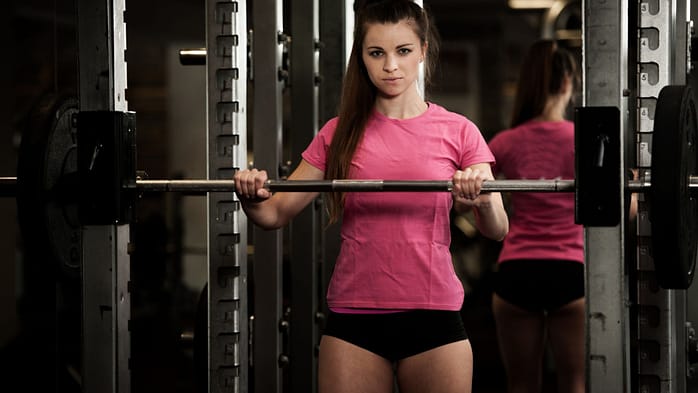Anterior pelvic tilt is a common postural issue that can lead to discomfort and even pain. It’s characterized by the forward tilting of the pelvis, often caused by muscle imbalances, prolonged sitting, or improper exercise techniques. Addressing this concern requires a thoughtful approach, including specific squat variations that can help correct this imbalance.

Table of Contents
ToggleUnderstanding Anterior Pelvic Tilt
Before diving into squat variations, let’s briefly understand what anterior pelvic tilt is and how it affects the body. When the pelvis tilts forward, it exaggerates the curve of the lower back, causing the abdomen to protrude and the glutes to appear flatter. This imbalance can lead to lower back pain, tight hip flexors, and weakened glutes and abdominals.
Recommended Squat Variations
1. Goblet Squats
This variation involves holding a kettlebell or dumbbell close to your chest while squatting.
How it helps: Goblet squats encourage an upright torso, engaging the core and teaching proper hip hinge mechanics.

2. Front Squats
With the barbell resting on the front of your shoulders, perform squats.
How it helps: Front squats promote an upright posture, engaging the core and upper back, which can counteract the pelvic tilt.
3. Box Squats
Squatting onto a box or bench at parallel or slightly below before returning to standing.
How it helps: Box squats assist in maintaining consistent depth, encouraging proper form and pelvic alignment.
4. Split Squats
Stand in a split stance and lower your body until both knees are at a 90-degree angle.
How it helps: Split squats isolate each leg, aiding in addressing strength imbalances that might contribute to pelvic tilt.
5. Sumo Squats
Adopt a wide stance with toes pointing outwards and perform squats.
How it helps: Sumo squats target the inner thighs and glutes, contributing to overall hip mobility and strength.
Points to Consider
Form over Weight: Prioritize perfecting your form before adding significant weight to any squat variation.
Range of Motion: Focus on achieving a full range of motion without compromising your form to reap maximum benefits.
Consistency is Key: Incorporate these variations consistently into your workout routine for lasting improvements.
So.
Incorporating specific squat variations into your fitness routine can be beneficial in addressing anterior pelvic tilt. Remember though, that it’s very important to pair these exercises with a well-rounded workout routine that includes stretching, core strengthening, and overall postural awareness. By doing so, you’ll not only correct the tilt but also enhance your overall strength and mobility.
Maintaining Correct Form and Progression
When aiming to correct anterior pelvic tilt through squat variations, ensuring correct form is paramount. Here are additional tips to maintain proper technique and progress effectively:
6. Mindful Breathing
Focus on controlled breathing throughout the squat movement. Inhale deeply before descending and exhale as you ascend, engaging your core muscles.
7. Core Engagement
Prioritize engaging your core muscles throughout each squat variation. A strong core helps stabilize the pelvis and supports proper posture.
8. Gradual Progression
Start with bodyweight squats or lighter weights to perfect your form. Gradually increase resistance as your technique improves.
9. Mobility Work
Incorporate hip flexor stretches, hamstring stretches, and mobility exercises into your routine. Improved flexibility can assist in correcting pelvic tilt.
10. Professional Guidance
Consider consulting a fitness professional or physical therapist for personalized advice and exercises tailored to your specific needs.
External Resources for Deeper Insight:
Fix Anterior Pelvic Tilt by Improving Hip Flexor Mobility – Precision Movement
The Ultimate Guide to Mastering Squat Technique – BarBend
Pelvic Tilt Exercises for a Stronger Core – Verywell Fit
How to Correct Anterior Pelvic Tilt: Exercises and Stretches – Healthline
Squats for Posture: Benefits and Variations – Self
The Ultimate Guide to Squats – Muscle & Fitness
Conclusion
Incorporating a variety of squat variations into your fitness regimen can significantly contribute to correcting anterior pelvic tilt. However, remember that no single exercise can entirely fix the issue. It’s crucial to combine these exercises with a holistic approach that includes stretching, strengthening, and paying attention to overall posture and muscle balance.
Consistency, proper form, and patience are key elements in addressing anterior pelvic tilt. Embrace these squat variations as part of a comprehensive plan to improve your posture, alleviate discomfort, and promote overall strength and flexibility. Always listen to your body, and if you experience persistent pain or discomfort, seek advice from a healthcare professional.
By adopting a well-rounded fitness routine and incorporating these squat variations, you’re taking proactive steps towards better posture, enhanced mobility, and a healthier lifestyle.
Comparison tabular
| Squat Variation | Description | Benefits |
|---|---|---|
| Goblet Squats | Hold a weight close to chest while squatting. | – Encourages an upright torso.<br>- Engages the core and teaches proper hip hinge mechanics. |
| Front Squats | Barbell on front shoulders while squatting. | – Promotes an upright posture.<br>- Engages the core and upper back, counteracting pelvic tilt. |
| Box Squats | Squat onto a box or bench at parallel height. | – Assists in maintaining consistent depth.<br>- Encourages proper form and pelvic alignment. |
| Split Squats | Stand in a split stance and lower the body. | – Isolates each leg, addressing strength imbalances. |
| Sumo Squats | Wide stance with toes pointing outwards. | – Targets inner thighs and glutes, enhancing hip mobility. |
Comparison Overview:
Goblet Squats: Emphasizes core engagement and proper hip mechanics.
Front Squats: Focuses on an upright posture and engages the core and upper back.
Box Squats: Aids in maintaining depth and proper form with pelvic alignment.
Split Squats: Isolates legs to address strength imbalances effectively.
Sumo Squats: Targets inner thighs and glutes, enhancing hip mobility.
Each variation contributes uniquely to correcting anterior pelvic tilt. Consider incorporating a mix of these squat variations into your routine, paying attention to proper form and gradually increasing resistance for optimal results.
Wrapping up
Correcting anterior pelvic tilt is a journey that involves dedication, patience, and a holistic approach to fitness. Incorporating specific squat variations into your workout routine can be incredibly beneficial, but it’s essential to remember that no single exercise holds the complete solution.
Consistency, proper form, and a well-rounded approach that includes stretching, strengthening, and overall postural awareness are crucial. Listen to your body, progress gradually, and seek guidance from fitness professionals or healthcare experts if needed.
By embracing these squat variations alongside a comprehensive plan, you’re taking proactive steps toward better posture, reduced discomfort, and improved overall strength and flexibility. Stay committed to your fitness journey, and enjoy the benefits of a healthier, more balanced body.

Hey there, it’s Mike Rrsq, the Editor-in-Chief over at Jsquat.com, and I’m absolutely obsessed with all things squat fitness! I’ve been lucky enough to get some serious recognition for my work in this field. With a solid background in the fitness and wellness industry, I’ve been there right from the get-go, helping shape this website into what it is today.
You see, I’m not just the boss around here; I’m also a passionate contributor. I love sharing my insights through my articles, and trust me, they’re not your run-of-the-mill stuff. Each piece I write is a labor of love, filled with my expertise and real-world experience in the fitness universe. So, if you’re into fitness and looking for some inspiration, you’re in the right place!
Related Posts
- The top 3 effective squat Variations females need for correcting posterior pelvic tilt.
Posterior pelvic tilt is a condition where the pelvis rotates backward, causing the lower back…
- The top 3 effective squat Variations for correcting lateral pelvic tilt in 25-year-old females
Lateral pelvic tilt is a common issue that can affect posture and overall body alignment.…
- The Best 5 Most Effective Squat patterns you need to do for targeting the rectus abdominis.
Targeting the rectus abdominis, commonly known as the "six-pack" muscles, through squats requires specific variations…
- Beat 3 squat patterns you need for targeting the semitendinosus and semimembranosus muscles
Squats are a cornerstone of strength training, engaging various muscle groups across the lower body.…
- Best 6 squat Patterns you need to do for targeting the vastus lateralis?
Targeting the vastus lateralis, one of the quadriceps muscles, involves specific squat variations. To zero…
- How can Ballet Squat (Plie Squat) help improve balance
The ballet squat, also known as a plié squat, is a fantastic exercise for enhancing…
- If you cant single leg squat then should you be doing a full squat
Whether or not to attempt a full squat if you can't perform a single-leg squat…
- Should female front squat harder than the back squat for glutes and tights
Front squats and back squats are both excellent exercises that engage various muscles, including the…

